Alberto Antonietti, Claudia Casellato, Jesús A. Garrido, Niceto R. Luque, Francisco Naveros, Eduardo Ros, Egidio D’Angelo, and Alessandra Pedrocchi, Politecnico di Milano, University of Granada, University of Pavia, Italy
The human nervous system has always been studied from many different points of view and the advancements in the IT field allow scientists and engineers to exploit the new technologies to model and mimic the brain circuitry. Computational neuroscience combines neurophysiology with informatics to build models of the nervous system, starting from the single neuron towards circuits composed of thousands of interconnected neurons. In this work, we propose a realistic model of an important element of the central nervous system, the cerebellum. It is a fundamental processing unit for a large number of cognitive and motor tasks. One of the most studied paradigms of cerebellum involvement is the eye blink classical conditioning. We present a realistic cerebellar model, which consists of an artificial Spiking Neural Network (SNN) equipped with distributed plasticity mechanisms that go beyond the classic single-plasticity architectures. The model has sound neurophysiological bases and it benefits from an open-source SNN simulator that speeds up the network processing. The SNN was tested in the eye blink classical conditioning with a multi-session paradigm. We developed an evolutionary algorithm in order to tune the model parameters, since the complexity of the search-space. By varying experimental conditions and stimuli patterns, also the robustness of the model has been investigated. Through the designed protocol, comparing the distributed plasticity model with the corresponding single plasticity model, we have shed light on acquisition, extinction and consolidation processes, associable to the different active plasticity sites. The cortical and nuclear plasticity mechanisms, implementing mutual memory transfer, made the cerebellar controller able to express neurophysiological behavioral properties, optimizing the learning on multiple time-scales. This study presents a very advanced computational model that, with its realistic features, can provide confirmations and suggestions about neurophysiological and pathological hypotheses.
http://www.nearlab.polimi.it
http://code.google.com/p/edlut/
http://www-5.unipv.it/dangelo/
Keywords: cerebellum, neuroengineering, computational neuroscience, distributed plasticity, genetic algorithm, model tuning, motor learning, Pavlovian conditioning.


